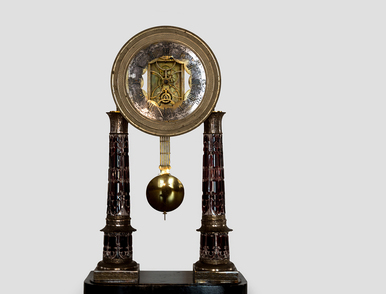The first mantel or shelf clocks were smaller copies of longcase clocks. As clockmaking evolved, their designs were improved, and new models appeared.
The displayed model is one of the most brilliant examples of mid-19th-century clockmaking. It is made of mahogany, richly decorated, and equipped with chimes and a calendar.
The clock face is equipped with a main dial indicating the time and a calendar showing the current date. Every five days, from 5 to 31, are marked on the calendar dial.
The three holes on the main dial are intended for winding the clock movement, the musical mechanism, and the chimes. Two upper dials with blued steel hands were intended for turning off the chimes and selecting one of the six striking sequences.
This is a pendulum clock that has a bell-shaped lens and a fusee. A fusee is a special device used in spring-driven mechanical clocks and designed to equalize the uneven pull of the mainspring as it runs from the drum to the wheel system. As the spring unwinds, the fusee compensates for the diminishing spring force, ensuring accurate timekeeping between the two windings.
John Taylor was an English clockmaker of Scottish descent who founded and owned a clockmaking firm in the first half of the 19th century. John Taylor’s ancestors lived in Perth and worked as blacksmiths. However, after John’s father died, his mother sent him to be an apprentice to the clockmaker Richard Bloomer. After four years of apprenticeship, John Taylor continued to work as an assistant for some time but soon started teaching his own students. Over time, together with his brother James, he established his own clock factory.
Most of John Taylor’s products were aimed for
export and commissioned by the royal courts, especially by the Russian and
Spanish ones. After John Taylor’s death, his factory was bought by Robert Wood
who decided to keep his predecessor’s name on the engraved trademark since it
was a recognizable brand that guaranteed the firm’s excellent reputation.






